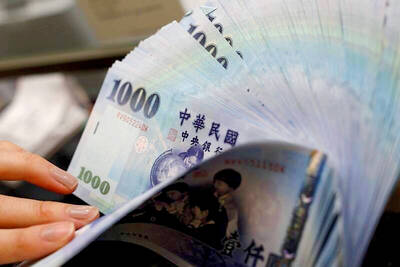US crude futures on Friday topped US$80 a barrel for the first time since November 2014 as a global energy crisis boosts demand at a time when OPEC+ producers are keeping supplies tight.
West Texas Intermediate (WTI) for November delivery popped above the key psychological level before pulling back and closing up 1.34 percent at US$79.35 a barrel, gaining 4.57 percent from a week earlier.
Brent crude for December delivery increased 0.54 percent a barrel to US$82.39, up 3.92 percent from a week earlier.

Photo: Reuters
This week brought many indications that supplies would remain constrained: Saudi Aramco said a global natural gas shortage was already boosting oil demand for power generation and heating, and the US Energy Department said that it had no plans “at this time” to tap the nation’s oil reserves.
A weakening of the US dollar on the back of worse-than-expected US labor market data on Friday also boosted the appeal of commodities priced in the currency.
The US benchmark posted a seventh straight weekly gain, the longest stretch of advances since December last year.
The economic recovery from the COVID-19 pandemic, along with supply disruptions in the Gulf of Mexico, had already tightened the market before rising natural gas prices spurred additional demand for oil products such as diesel and fuel oil.
The decision by OPEC producers and their allies to only modestly increase output next month threatens to further constrain supplies.
Meanwhile, various underlying oil market gauges are also showing signs of strength. WTI’s nearest contract traded at the biggest premium to second-month futures since August in a sign of rising demand and tight supplies.
The so-called prompt spread has increased as more of the world attempts to substitute fuel oil for natural gas as quickly as possible.
“They don’t need to buy it a month from now, they needed it yesterday,” said Bob Yawger, director of the futures division at Mizuho Securities USA. “It’s a panic buyer’s situation.”
Meanwhile, China is still facing power outages, and Beijing has ordered state-owned firms to secure winter energy supplies at all costs. Chinese fuel oil futures jumped almost 10 percent on Friday.
Additional reporting by staff writer

Merida Industry Co (美利達) has seen signs of recovery in the US and European markets this year, as customers are gradually depleting their inventories, the bicycle maker told shareholders yesterday. Given robust growth in new orders at its Taiwanese factory, coupled with its subsidiaries’ improving performance, Merida said it remains confident about the bicycle market’s prospects and expects steady growth in its core business this year. CAUTION ON CHINA However, the company must handle the Chinese market with great caution, as sales of road bikes there have declined significantly, affecting its revenue and profitability, Merida said in a statement, adding that it would

MARKET LEADERSHIP: Investors are flocking to Nvidia, drawn by the company’s long-term fundamntals, dominant position in the AI sector, and pricing and margin power Two years after Nvidia Corp made history by becoming the first chipmaker to achieve a US$1 trillion market capitalization, an even more remarkable milestone is within its grasp: becoming the first company to reach US$4 trillion. After the emergence of China’s DeepSeek (深度求索) sent the stock plunging earlier this year and stoked concerns that outlays on artificial intelligence (AI) infrastructure were set to slow, Nvidia shares have rallied back to a record. The company’s biggest customers remain full steam ahead on spending, much of which is flowing to its computing systems. Microsoft Corp, Meta Platforms Inc, Amazon.com Inc and Alphabet Inc are

RISING: Strong exports, and life insurance companies’ efforts to manage currency risks indicates the NT dollar would eventually pass the 29 level, an expert said The New Taiwan dollar yesterday rallied to its strongest in three years amid inflows to the nation’s stock market and broad-based weakness in the US dollar. Exporter sales of the US currency and a repatriation of funds from local asset managers also played a role, said two traders, who asked not to be identified as they were not authorized to speak publicly. State-owned banks were seen buying the greenback yesterday, but only at a moderate scale, the traders said. The local currency gained 0.77 percent, outperforming almost all of its Asian peers, to close at NT$29.165 per US dollar in Taipei trading yesterday. The

The US overtaking China as Taiwan’s top export destination could boost industrial development and wage growth, given the US is a high-income economy, an economist said yesterday. However, Taiwan still needs to diversify its export markets due to the unpredictability of US President Donald Trump’s administration, said Chiou Jiunn-rong (邱俊榮), an economics professor at National Central University. Taiwan’s exports soared to a record US$51.74 billion last month, driven by strong demand for artificial intelligence (AI) products and continued orders, with information and communication technology (ICT) and audio/video products leading all sectors. The US reclaimed its position as Taiwan’s top export market, accounting for